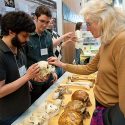Undergrad team debuts in genetic engineering competition
For the first time, a team of UW–Madison undergraduates participated in the annual International Genetically Engineered Machine Competition (iGEM), held this fall at the Massachusetts Institute of Technology.
The UW–Madison students participated alongside more than 50 teams from around the world. And the team has set its sights on expanding in 2008.
The iGEM competition offers students an excellent way to get interested in the life sciences, says faculty team advisor Franco Cerrina, a UW–Madison professor of electrical and computer engineering and director of the Center for NanoTechnology.
"Now that we know the sequence of DNA in many genomes, we can begin to think how to modify, or engineer, them," he says. "Our plan is to get more engineers involved in these kinds of problems, and to stimulate the interest of undergraduate students in these areas."
The team members came from distinct academic backgrounds. Nathan Klapoetke is an electrical engineering student, David "Tug" Peterson is a genetics student and Sean McMaster is a biochemistry and math student. The three worked full-time over the summer to build an artificial transcription factor (ATF) to control gene expression. Their idea came from the work of Aseem Ansari, a UW–Madison assistant professor of biochemistry, while Doug Weibel, an assistant professor of biochemistry, provided advice and lab support.
Klapoetke says the bulk of their work was designing a "zinc finger" ATF to bind to a particular gene, using a protein to control the gene’s activity. A zinc finger is a large group of protein domains that rely on the zinc ion for stability. The iGEM team selected a gene crucial to programmed cell death and targeted the protein BCL-2 that is directly involved in the cascade of cell-death proteins. The team was the first to test the particular zinc finger on a microarray developed in Cerrina’s laboratory.
Though the UW–Madison project was mainly foundational research, the ability to prevent cell death has many potential medical applications. During cancer treatment, large doses of the common chemotherapy drug, Doxrubicin, can start killing cells, and preventing cells from dying under oxidative stress could make a major difference for patients.
There are also applications in cardiomyopathy and alleviating the effects of heart disease, says Peterson.
The iGEM competition has grown exponentially in only a few years. It began as a single MIT class project in 2003 and when the competition first went international in 2005, only 13 teams were present.
The current team is seeking additional members from a variety of backgrounds and plans to grow to 10 to 12 students for the upcoming competition. This year, the group received UW–Madison funding and assistance from the College of Engineering 2010 Initiative, the National Science Foundation-funded Materials Research Science and Engineering Center and the NSF Nanoscale Science and Engineering Center, the Genomic Sciences Training Program, and the UW–Madison Chancellor’s Fund.
Using new developments in biology, Cerrina, Ansari and Weibel are planning a new course, "Synthetic Biology for Engineers," to introduce engineering students to system biology. Students taking this course may participate in the summer-long iGEM project.
Overall, it’s a worthwhile investment of time and effort, says student team member McMaster. The iGEM competition is about picking a novel topic that people can recognize as really neat. "It kind of entices them to look more at the mechanics and applications that science has in the real world," he says.
The team members agree that the iGEM has expanded their view of science in new fields. "The main spirit of the iGEM is really seeing what’s possible," says teammate Klapoetke. "What can people make? And, meeting the students for all the other teams was really cool."
Tags: biosciences, engineering, events, international, student life



